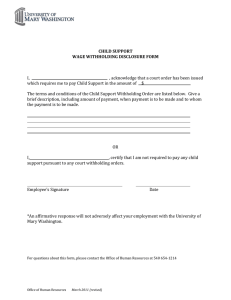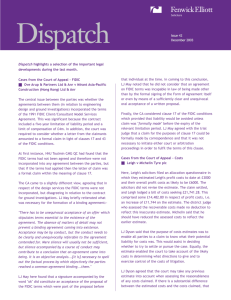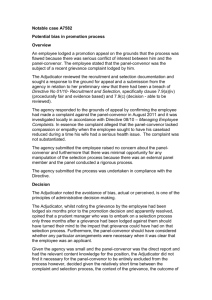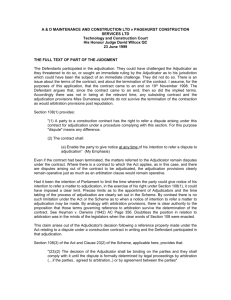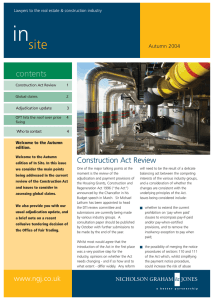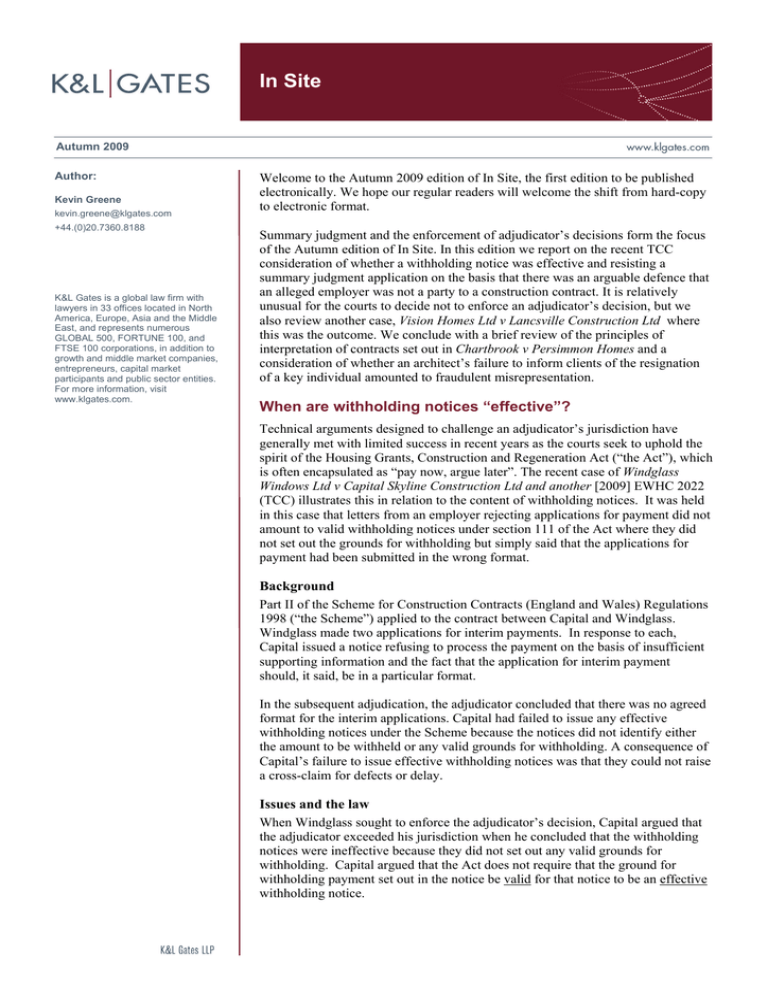
In Site
Autumn 2009
Author:
Kevin Greene
kevin.greene@klgates.com
+44.(0)20.7360.8188
K&L Gates is a global law firm with
lawyers in 33 offices located in North
America, Europe, Asia and the Middle
East, and represents numerous
GLOBAL 500, FORTUNE 100, and
FTSE 100 corporations, in addition to
growth and middle market companies,
entrepreneurs, capital market
participants and public sector entities.
For more information, visit
www.klgates.com.
Welcome to the Autumn 2009 edition of In Site, the first edition to be published
electronically. We hope our regular readers will welcome the shift from hard-copy
to electronic format.
Summary judgment and the enforcement of adjudicator’s decisions form the focus
of the Autumn edition of In Site. In this edition we report on the recent TCC
consideration of whether a withholding notice was effective and resisting a
summary judgment application on the basis that there was an arguable defence that
an alleged employer was not a party to a construction contract. It is relatively
unusual for the courts to decide not to enforce an adjudicator’s decision, but we
also review another case, Vision Homes Ltd v Lancsville Construction Ltd where
this was the outcome. We conclude with a brief review of the principles of
interpretation of contracts set out in Chartbrook v Persimmon Homes and a
consideration of whether an architect’s failure to inform clients of the resignation
of a key individual amounted to fraudulent misrepresentation.
When are withholding notices “effective”?
Technical arguments designed to challenge an adjudicator’s jurisdiction have
generally met with limited success in recent years as the courts seek to uphold the
spirit of the Housing Grants, Construction and Regeneration Act (“the Act”), which
is often encapsulated as “pay now, argue later”. The recent case of Windglass
Windows Ltd v Capital Skyline Construction Ltd and another [2009] EWHC 2022
(TCC) illustrates this in relation to the content of withholding notices. It was held
in this case that letters from an employer rejecting applications for payment did not
amount to valid withholding notices under section 111 of the Act where they did
not set out the grounds for withholding but simply said that the applications for
payment had been submitted in the wrong format.
Background
Part II of the Scheme for Construction Contracts (England and Wales) Regulations
1998 (“the Scheme”) applied to the contract between Capital and Windglass.
Windglass made two applications for interim payments. In response to each,
Capital issued a notice refusing to process the payment on the basis of insufficient
supporting information and the fact that the application for interim payment
should, it said, be in a particular format.
In the subsequent adjudication, the adjudicator concluded that there was no agreed
format for the interim applications. Capital had failed to issue any effective
withholding notices under the Scheme because the notices did not identify either
the amount to be withheld or any valid grounds for withholding. A consequence of
Capital’s failure to issue effective withholding notices was that they could not raise
a cross-claim for defects or delay.
Issues and the law
When Windglass sought to enforce the adjudicator’s decision, Capital argued that
the adjudicator exceeded his jurisdiction when he concluded that the withholding
notices were ineffective because they did not set out any valid grounds for
withholding. Capital argued that the Act does not require that the ground for
withholding payment set out in the notice be valid for that notice to be an effective
withholding notice.
In Site
Section 111 of the Act prevents a party from
withholding payment unless "an effective notice
of intention to withhold payment" has been given.
To be effective, such a notice must specify the
“amount proposed to be withheld and the ground
for withholding payment" (or grounds, if
applicable). Subsequent authorities have
established that, to be effective, withholding
notices must be in writing (Strathmore Building
Services v Colin Greig [2001] 17 Const LJ 72)
and must be issued a requisite time before the
final date for payment (VHE v RBSTB [2000]
BLR 187). The courts will take a practical view
of the contents of a withholding notice and will
not allow complaints as to form which might be
described as artificial or contrived (Thomas Vale
Construction v Brookside Syston Ltd [2006]
EWHC 3637).
Judgment
The judge enforced the adjudicator’s decision for
a number of reasons. On the issue of whether the
notices constituted effective withholding notices
within the meaning of section 111 of the Act, the
judge concluded that, if the requirements of
section 111 are not met, a notice is not effective
and there is no "meaningful distinction between a
‘valid’ or an ‘effective’ notice".
Capital had argued that it knew it had a
substantial counterclaim but that it also "had
good grounds to forestall a payment application
that was not in a format previously agreed". It
therefore withheld on the latter grounds and then
defended the adjudication on the substantial
grounds - the notice was effectively used as a
"foot in the door". The judge rejected this
argument, emphasising the obligation of the
paying party to give good reasons there and then
if it wishes to withhold. Otherwise, it has to pay
now and argue later. The absence of an effective
withholding notice is fatal to the bringing of the
cross-claim and therefore means that the
adjudicator’s decision must be enforced.
Summary judgment applications
Estor Limited v Multifit (UK) Limited (2009)
EWHC 2108 (TCC) represents a relatively rare
instance of the courts not enforcing an
adjudicator’s decision at summary judgment
stage. In this case the judge refused to enforce on
the basis that the alleged employer had an
arguable defence that it was not a party to the
construction contract. This case is a reminder that
an employer and sub-contractor should give full
consideration to their relationship by formally
entering into a contract when a contractor leaves
the scene and the sub-contractor is to finish off
the work.
Background
Mr Keith Warner was the owner of the Ginger
Group of companies (of which Estor Limited
was the holding company) who engaged Hub
Design Ltd for the fit-out works on newly
acquired shop premises. The contract identified
the Ginger Group as the employer. Hub subcontracted some of the works to Multifit (UK)
Ltd. Matters did not proceed smoothly, with
Hub leaving the project and Multifit agreeing to
finish the work. Mr Warner sent an email
confirming that Multifit should carry out the
work in accordance with an agreed revised
quote, but failed to indicate which company was
accepting the quotation. Multifit was paid for
the work but it was unclear which group
company had made the payments.
The resin floor was expressly excluded from
both the original and revised scope of Multifit’s
work. This aspect of the work was carried out by
another of Hub’s subcontractors, who were paid
by Multifit (allegedly under Mr Warner's
direction). A dispute arose over defects in the
resin flooring and who was responsible for them.
The adjudicator found that there was a contract
between Estor and Multifit (evidenced by the
emails of Multifit and Mr Warner and a credit
reference application signed by Mr Warner) and
that, although the resin floor was not originally
part of Multifit’s works, it became part of them
and Multifit was responsible to Estor for defects
in it (although on the facts none were proved).
Estor was ordered to pay Multifit's costs and the
majority of the adjudicator's fee.
Enforcement proceedings
Estor did not pay and sought declarations that (1)
there was no contract with Multifit and (2) the
adjudicator’s decision was unenforceable.
Multifit counterclaimed seeking summary
judgment to enforce the adjudicator’s decision.
To resist summary enforcement of the
adjudicator’s award, Estor needed to satisfy the
court that there was a realistic prospect of
establishing that the contract was not between
Estor and Multifit.
Autumn 2009
2
In Site
On the evidence, the judge held that there was a
realistic prospect of Estor establishing that it was
not the company which entered into the contract
with Multifit due to the evidence from Mr
Warner and the payments which were made by
another group company (albeit funded by Estor).
The evidence against Estor included the credit
reference application which expressly cited Estor.
The court could only decide the issue by hearing
oral evidence at a full hearing. Estor was given
leave to defend the summary judgment
application. The judge said, however, that as the
defence raised by Estor was “at the weaker end of
the scale”, Estor was required to make a payment
into court of £35,000 (being just over half the
sum claimed by Multifit). This reflected the
court’s relative scepticism about the strengths of
Estor’s case.
Vision Homes Ltd v Lancsville
Construction Ltd
Compliance with the procedure for nominating an
adjudicator was at the heart of the successful
challenge to the adjudicator’s jurisdiction in the
recent case of Vision Homes Ltd v Lancsville
Construction Ltd [2009] EWHC 2042 (TCC).
Vision engaged Lancsville to construct the shell
and external envelope of new flats. The external
envelope element of the works was subsequently
omitted and the contract sum reduced.
The remaining works were rescheduled but
delays occurred. Vision claimed liquidated
damages from Lancsville, who disputed this. It
argued that, as part of the agreement to omit
work, Vision was not entitled to liquidated
damages.
Both parties launched adjudications against the
other on the same day, with Lancsville seeking a
declaration that Vision was not entitled to levy
liquidated damages, whilst Vision claimed
liquidated damages. The Scheme applied to both
adjudications. This case concerns the first of
those adjudications.
Lancsville sent its notice of intention to refer a
dispute to adjudication to Vision early on the
morning of 14 May 2009, seeking its agreement
to one of three named adjudicators. Later that day
Lancsville requested the RICS to make an
appointment and shortly thereafter on the same
day Lancsville sent Vision a slightly modified
notice of intention, which now included a claim
for Vision to pay the adjudicator’s fees and
expenses ("the Second Notice").
Five days later, on 19 May, Mr Bingham
accepted his nomination as adjudicator by the
RICS and on the following day Lancsville served
its referral notice in that adjudication (“the
Bingham adjudication”). The adjudicator decided
that Vision was not entitled to deduct liquidated
damages as the agreement to omit the works also
removed the extension of time and liquidated
damages provisions. He also ordered Vision to
pay his fees and expenses, which demonstrated
that he was proceeding under the Second Notice.
Vision wrote to Mr Alway, the adjudicator on the
other dispute (the “Alway adjudication”), saying
that the Bingham adjudication was not binding
on him, whilst Lancsville wrote to him asking
him to resign in the light of the decision in the
Bingham adjudication. Mr Alway decided that
the Bingham adjudication did not relate to
substantially the same dispute as that in the
Alway adjudication, but suggested that the
parties should obtain guidance from the court on
the validity of the decision in the Bingham
adjudication before he issued his decision.
Vision then started proceedings in the courts, in
which it set out several grounds why Mr
Bingham’s decision was invalid. The only
successful ground (lack of clarity of the decision,
unfairness and two adjudications on the same
point all failing) was the timing of the notices of
intention to refer and the request to the RICS to
nominate an adjudicator.
The Scheme provides (paragraph 2 (1)) that
“following the giving of a notice of adjudication
… the referring party shall request the
nominating body … to select a person to act as
adjudicator.” Vision argued that this sequence
was not followed, as Mr Bingham had proceeded
on the basis of the Second Notice which had
followed the request to the RICS, rather than
preceded it as required by the Scheme.
The judge agreed with Vision and held that “not
without some misgiving I accept that the
adjudicator had no jurisdiction to act, as he did,
under the second notice of 14 May because that
notice was not followed but preceded by a
request to the nominating body”.
Autumn 2009
3
In Site
The “misgiving” arose from the fact that the
alteration to the notice adding a claim for fees
was of limited importance compared with the
dispute as a whole. However, because in other
circumstances the amendment may be more
significant, the judge found that the question of
jurisdiction “cannot depend upon the degree of
importance of the additional claim”.
Interpretation of contracts
Chartbrook Limited v Persimmon Homes Limited
and others [2009] UKHL 38 illustrates the extent
to which the courts will be prepared to go to
interpret a contract to give effect to the parties’
intentions and clarifies the established rule –
known as the exclusionary rule – that evidence of
pre-contractual negotiations is not admissible for
the purposes of interpreting a contract.
Chartbrook and Persimmon disagreed over the
interpretation of a pricing formula in a
development contract. Chartbrook said the
payment provision should be interpreted literally,
whilst Persimmon argued that Chartbrook’s
interpretation did not give it a rational,
commercial meaning. Both the court of first
instance and the Court of Appeal found in favour
of Chartbrook. Persimmon appealed to the House
of Lords on the basis that its construction of the
provision was correct and, in the alternative, that
their Lordships should take into account precontractual negotiations in interpreting the
provision. It argued that the exclusionary rule
was illogical and prevented a court from putting
itself in the position of the parties and
ascertaining their true intent.
With regard to the parties’ main arguments, the
House of Lords found in favour of Persimmon
and concluded that something had gone wrong
with the language of the contract. As such,
Chartbrook’s interpretation of the clause was
“arbitrary and irrational”. Since the payment
provision clearly contained a mistake and it was
clear to the House how to correct that mistake,
the House was able to effect the correction. In
order to do this the court will look at the
background matrix of facts when interpreting
the contract.
In reaching this decision, the House considered a
pre-contractual letter put forward by Persimmon
which clarified the commercial purpose of the
payment clause. Whilst maintaining the status
quo regarding the exclusionary rule, their
Lordships accepted that there are no conceptual
limits as to what may be regarded as background
evidence (BCCI v Ali (No 1)). So, prima facie,
evidence of pre-contractual communications
between the parties may be relevant (and
therefore admissible) as part of the background
which might cast light on what the parties meant
by the language they used.
The question is whether this represented a
departure from the exclusionary rule. The answer
is no: the House refused to go so far. Lord
Hoffmann noted that
there are two important safeguards which operate
to prevent the exclusionary rule from causing
injustice: (1) rectification if the agreement
mistakenly does not reflect the common agreed
intention of the parties and (2) estoppel by
convention if the parties have agreed that certain
words will have a particular meaning. In clearly
restating the exclusionary rule, the case is a
reminder that evidence of relevant precontractual negotiations is only likely to get
before a judge if arguments of rectification or
estoppel by convention can be raised.
This case is a salutary lesson to those drafting
contracts to avoid ambiguity. With particular
regard to payment clauses, parties could provide
worked examples of payment calculations,
minimise the number of defined terms used or
rely on a simple formula. However, where errors
do occur, parties may be able to seek the
assistance of the court who will assume the role
of a “reasonable person”.
Fraudulent misrepresentation
Whilst it is common practice for an employer to
engage an architectural practice as “architect” on
a project, the understanding (often made an
express term of the contract) is that specific
individuals within that practice will devote some,
if not all, of their time to the project.
The issue which came up in Fitzroy Robinson
Ltd v Mentmore Towers Ltd [2009] EWHC 1552
was whether a failure to inform clients of the
resignation of one such key individual amounted
to fraudulent misrepresentation.
A director of Fitzroy Robinson Ltd (the
architect) had been expected to carry out a key
role on two projects for a client, Mentmore
Towers Ltd. He resigned, however, before the
professional appointments were signed. Fitzroy
did not tell Mentmore of the resignation until 8
months later.
Autumn 2009
4
In Site
It was decided on the facts that this amounted to
fraudulent misrepresentation. Although the case
does not make new law, it does provide a number
of important practical lessons, first and foremost
of which is that professional consultants should
promptly inform their clients of key personnel
changes. Even if a failure to do so does not
amount to misrepresentation, it may amount to
breach of contract (for example if key personnel
are stated in the contract) and may cause damage
to the professional consultant's reputation.
Anchorage Austin Beijing Berlin Boston Charlotte Chicago Dallas Dubai Fort Worth Frankfurt Harrisburg Hong Kong London
Los Angeles Miami Newark New York Orange County Palo Alto Paris Pittsburgh Portland Raleigh Research Triangle Park
San Diego San Francisco Seattle Shanghai Singapore Spokane/Coeur d’Alene Taipei Washington, D.C.
K&L Gates is a global law firm with lawyers in 33 offices located in North America, Europe, Asia and the Middle East, and represents
numerous GLOBAL 500, FORTUNE 100, and FTSE 100 corporations, in addition to growth and middle market companies, entrepreneurs,
capital market participants and public sector entities. For more information, visit www.klgates.com.
K&L Gates comprises multiple affiliated partnerships: a limited liability partnership with the full name K&L Gates LLP qualified in Delaware and
maintaining offices throughout the U.S., in Berlin and Frankfurt, Germany, in Beijing (K&L Gates LLP Beijing Representative Office), in Dubai,
U.A.E., in Shanghai (K&L Gates LLP Shanghai Representative Office), and in Singapore (K&L Gates LLP Singapore Representative Office); a
limited liability partnership (also named K&L Gates LLP) incorporated in England and maintaining offices in London and Paris; a Taiwan
general partnership (K&L Gates) maintaining an office in Taipei; and a Hong Kong general partnership (K&L Gates, Solicitors) maintaining an
office in Hong Kong. K&L Gates maintains appropriate registrations in the jurisdictions in which its offices are located. A list of the partners in
each entity is available for inspection at any K&L Gates office.
This publication is for informational purposes and does not contain or convey legal advice. The information herein should not be used or relied
upon in regard to any particular facts or circumstances without first consulting a lawyer.
©2009 K&L Gates LLP. All Rights Reserved.
Autumn 2009
5

